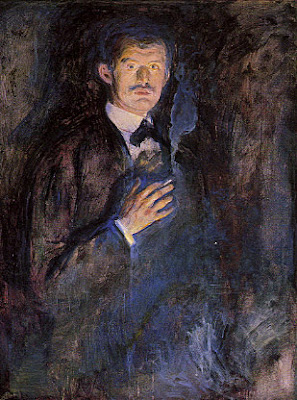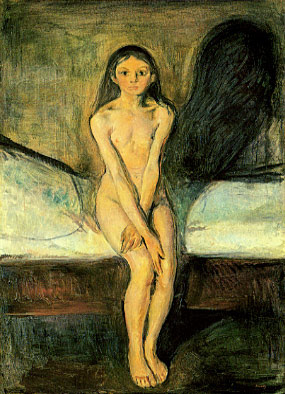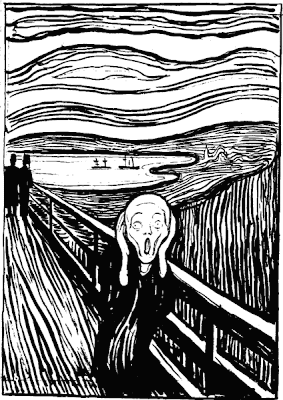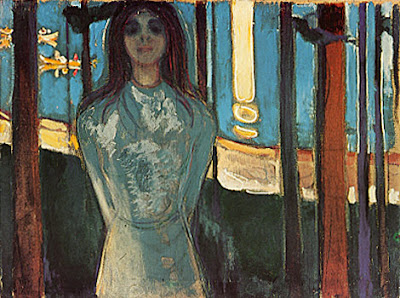Documentaries on Art

Private Life Of A Masterpiece
Edvard Munch’s
THE SCREAM
A BBC documentary
21st Jan 2012 ; 5.45 pm
Contemplate Art Gallery

Private Life Of A Masterpiece
Edvard Munch’s
THE SCREAM
A BBC documentary
21st Jan 2012 ; 5.45 pm
Contemplate Art Gallery
2 floor Rajshree Ford Bldg, Avanashi Rd ,
(opp) PSG Krishnammal College
http://www.facebook.com/profile.php?id=100003180985905

(opp) PSG Krishnammal College
http://www.facebook.com/profile.php?id=100003180985905

Edvard Munch
 Edvard Munch (1863-1944) was a turn-of-the-century Norwegian artist, best known for his extremely personal brand of Symbolism, which helped lay the foundations for and proved a lasting influence on the later Expressionist school of art.
Edvard Munch (1863-1944) was a turn-of-the-century Norwegian artist, best known for his extremely personal brand of Symbolism, which helped lay the foundations for and proved a lasting influence on the later Expressionist school of art. Munch began painting at the age of 17 in Kristiania . A state grant, awarded in 1885, enabled him to study briefly in Paris. For 20 years thereafter Munch worked chiefly in Paris and Berlin. At first influenced by impressionism and postimpressionism, he then turned to a highly personal style and content, increasingly concerned with images of illness and death.
Munch began painting at the age of 17 in Kristiania . A state grant, awarded in 1885, enabled him to study briefly in Paris. For 20 years thereafter Munch worked chiefly in Paris and Berlin. At first influenced by impressionism and postimpressionism, he then turned to a highly personal style and content, increasingly concerned with images of illness and death. n 1892, in Berlin, an exhibition of his paintings so shocked the authorities that the show was closed. Undeterred, Munch and his sympathizers worked throughout the 1890's toward the development of German expressionist art. Perhaps the best known of all Munch's work is The Scream (1893, Nasjonalgalleriet, Oslo). This, and the harrowing The Sick Child (1881-86, Nasjonalgalleriet), reflect Munch's childhood trauma, occasioned by the death of his mother and sister from tuberculosis.
n 1892, in Berlin, an exhibition of his paintings so shocked the authorities that the show was closed. Undeterred, Munch and his sympathizers worked throughout the 1890's toward the development of German expressionist art. Perhaps the best known of all Munch's work is The Scream (1893, Nasjonalgalleriet, Oslo). This, and the harrowing The Sick Child (1881-86, Nasjonalgalleriet), reflect Munch's childhood trauma, occasioned by the death of his mother and sister from tuberculosis. Melancholy suffuses paintings such as The Bridge —in limp figures with featureless or hidden faces, over which loom the threatening shapes of heavy trees and brooding houses. Reflections of sexual anxieties are seen in his portrayals of women, alternately represented as frail, innocent sufferers or as lurid, life-devouring vampires.
Melancholy suffuses paintings such as The Bridge —in limp figures with featureless or hidden faces, over which loom the threatening shapes of heavy trees and brooding houses. Reflections of sexual anxieties are seen in his portrayals of women, alternately represented as frail, innocent sufferers or as lurid, life-devouring vampires. In 1908 Munch's anxiety became acute and he was hospitalized. He returned to Norway in 1909 and died in Oslo on January 23, 1944. The relative tranquility of the rest of his life is reflected in his murals for the University of Oslo (1910-16), and in his vigorous, brightly colored landscapes. Although his later paintings are not as tortured as his earlier work, a return to introspection marks his late self-portraits, notably Between Clock and Bed (1940, Munch Musset, Oslo).
In 1908 Munch's anxiety became acute and he was hospitalized. He returned to Norway in 1909 and died in Oslo on January 23, 1944. The relative tranquility of the rest of his life is reflected in his murals for the University of Oslo (1910-16), and in his vigorous, brightly colored landscapes. Although his later paintings are not as tortured as his earlier work, a return to introspection marks his late self-portraits, notably Between Clock and Bed (1940, Munch Musset, Oslo). Munch's considerable body of etchings, lithographs, and woodcuts is now considered a significant force in modern graphic art; the work is simple, direct, and vigorous in style, and powerful in subject matter. Few of Munch's paintings are found outside Norway. His own collection is housed in the Munch Museet.
Munch's considerable body of etchings, lithographs, and woodcuts is now considered a significant force in modern graphic art; the work is simple, direct, and vigorous in style, and powerful in subject matter. Few of Munch's paintings are found outside Norway. His own collection is housed in the Munch Museet.
The Scream
Edvard Munch ‘s The Scream (1893) is his best-known painting of existential anguish. He created many versions of it. He appears to have drawn inspiration for it from one of the results of a volcano eruption far away. He writes on a diary page headed Nice 22.01.1892:
“ I was walking along a path with two friends - the sun was setting - suddenly the sky turned blood red - I paused, feeling exhausted, and leaned on the fence - there was blood and tongues of fire above the blue-black fjord and the city - my friends walked on, and I stood there trembling with anxiety - and I sensed an infinite scream passing through nature.”
The sky in the background of the painting may reflect the effects of the volcanic eruption of Krakatoa in 1883. The ash ejected from the volcano left the sky tinted red in most of Europe and Asia for several months and caused spectacular twilights with a magnificent, blood-red sky. Munch never forgot that sky, and why should he?
Munch explicitly mentioned that 1884 was the year of the original inspirations for three of the paintings in The Frieze of Life, where the most famous version of the Scream appears. The end result was an agonized figure against a blood red skyline. And who is screaming? Is it the depicted person, or is it nature? Or both? And is it Munch himself? Or a memory of a Peruvian mummy Munch had seen exhibited? It could be "a bit of this, a bit of that, and none can tell full well". In other words, the matter is open to interpretations.
The scene of the Scream includes a road overlooking Oslo, the Oslofjord and Hovedøya, on the slopes of a 140 m high hill called the Ekeberg. From this spot, Munch's direction of view in the drawing was toward the southwest, which is where the Krakatoa twilights appeared in the winter of 1883-1884.

No comments:
Post a Comment